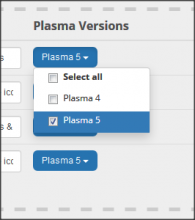It's been frequently observed that a very large proportion of the items available on store.kde.org flat-out don't work for users of recent versions of KDE Plasma, for a variety of reasons:
- Written for Plasma 4 and doesn't work in Plasma 5
- Written for older versions of Plasma 5 and incompatible with recent versions
- Just plain broken; installs, but doesn't work or isn't visible
- etc.
This degrades the user experience and is earning store.kde.org a very negative reputation. Let's figure out what we can do about this to turn the ship around.
Some random ideas:
- Hide all Plasma 4 content for Plasma 5 users
- Add a "compatible with" field and use that to determine what to show users of any particular Plasma version
- Allow community moderation; when enough users mark something as incompatible with a particular plasma version, it's automatically marked as incompatible with that version and hidden
- Do more curation; reach out to content authors and help them fix bugs and ensure that their content actually works properly
